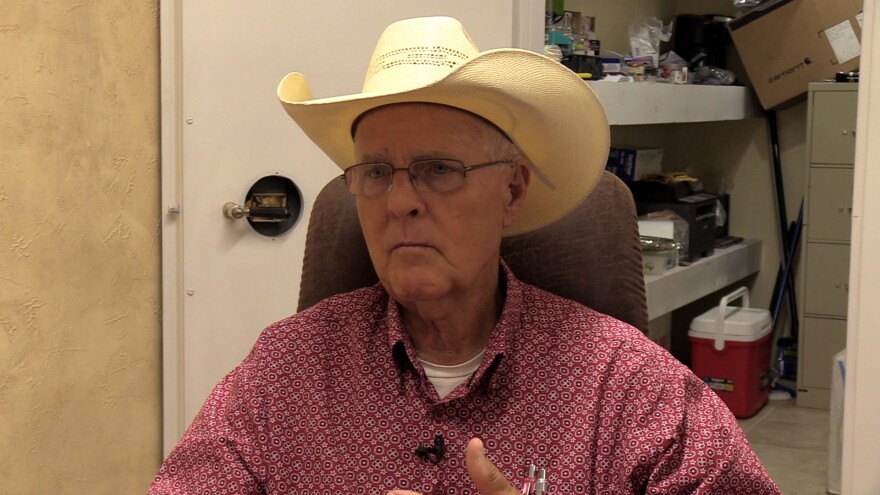This story is part of Shaky Ground, a collaborative reporting project between the Carlsbad Current-Argus and KRWG Public Media.
Oil and gas production has boomed in the Permian Basin in the last decade, driven by hydraulic fracturing, also known as fracking. Permian Basin oil production has risen to unprecedented levels of more than 5 million barrels per day, but it has drawn criticism due to environmental impacts, including an increase in emissions, produced water, and more recently, an increase in seismicity.
While there are calls for more regulation within the oil and gas industry, some within the industry say it’s safer than it’s ever been before, as well as an essential part of the economy. Hugh Box has worked in the oilfield industry since the mid-1970s and is part owner of Box-E Energy Services in Pecos, Texas. Hugh said that economically and practically, the oil and gas industry is a necessity.
“Technology [has] come a long, long way in this industry. And every one of the companies that I worked for, safety was one of the main things. Everybody complains about fossil fuel. Well, you’ve gotta have fossil fuel. And you know, solar and all that is fine, I’ve had solar panels running windmills, and when it gets cloudy, they don’t pump,” he said. “So it’s a growing thing, but you’ve got to have this. As technology goes and grows, it’s going to get even better on the pollution of [the planet].”

One of the byproducts of fracking is wastewater, known as produced water, which is often high in toxic metals and chemicals. Operators dispose of produced water by pumping it underground using disposal wells. Hugh said that the benefits outweigh the risks when it comes to drilling for oil in the Permian Basin.
“Oil and gas has built America. It has built people with making money. It has helped the economy. People just don’t understand, if they look at everything that’s built from the day one around oil and gas, every country makes their economy by oil and gas. So it can’t go away, and it’s not going to go away.”
While the industry does bring in significant money, some in the region are worried about the correlation between the increase in produced water injections and the number of earthquakes in the region.
In 2015 when the Permian was producing about 1.8 million barrels per day, there were 12 earthquakes region-wide with a magnitude two or greater as reported by the USGS. In 2022, with oil production at about 5.3 million barrels per day, the number of earthquakes skyrocketed to 2,404, with a magnitude 5.3 earthquake rumbling through the basin at the end of the year.
For Kayley Shoup, Community Organizer for Citizens Caring for the Future, an environmental group operating out of Carlsbad, the earthquakes are a sign that the region needs to move away from fossil fuel production, rather than lean into it.
“An earthquake is something that kinda spooks people, and it’s just something where the environmental impacts are suddenly in your face a little bit more,” she said. “I feel that it colors the politics of the area as well. Everything is kind of through a lens of ‘how do things affect the oil and gas industry in this region?’ Whether that’s federal action, or state action, it also keeps us from looking forward to the future. Because obviously we’re going to be leaning on renewable energy sources more and more as the years go on. And we’re not really thinking about that future here, because we’re so tied up in our economy and our reliance on oil and gas.”

Shoup said that while there are regulations to prevent environmental harm, she doesn’t trust that there are enough regulators in the state to enforce the law.
“We’re working with multibillion-dollar oil and gas companies here that have a really big stake in the game. They’re driving the conversation in a lot of ways, and so I think it just makes it a little bit difficult to engage in a truly meaningful way where we’re talking about the issues holistically,” she said. “You have the NASA satellite that has picked up two super-emitting sites here in the region. Those are things that we would have never known about if there wasn’t a satellite looking at these things. And then we also have that new air monitor in town that has already recorded four high-ozone days. That’s in violation of national ambient air quality standards. So, we’re getting the data that’s really saying [that] we’re trying to do this responsibly. But what’s actually happening in reality?”
At a national level, American oil drilling continues to ramp up, with U.S. field production of crude oil this year reaching its highest levels since the beginning of the pandemic. The expanded drilling means more economic opportunity for New Mexicans but leaves those skeptical of the industry worried about the harm that continued production might bring.



